The 9/11 Museum, which opened in 2014, is underground, reaching down about 70 feet to bedrock. It extends under the two memorial reflecting pools that mark the footprints of the World Trade Center’s Twin Towers, destroyed by terrorists in 2001.
The museum had to go below ground because it is obliged by law to preserve the original World Trade Center’s last remnants, which are at bedrock level, and to give the public “meaningful” access to them.
As a result, visitors see surviving parts of Twin Tower foundations and a retaining wall built to keep the Hudson River from flooding the area. Called the slurry wall, it held after 9/11 and saved the city much additional destruction.
Entry to the museum is via an elegant multifaceted glass pavilion, which admits lots of light.
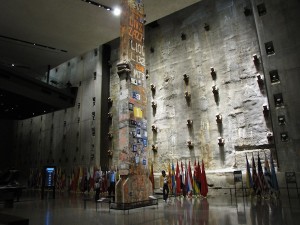
Foundation Hall, at bedrock level in the 9/11 Museum. The slurry wall, which survived the 9/11 destruction, is seen, along with the last steel beam to be removed from Ground Zero. Its removal marked the end of a nine-month recovery effort.
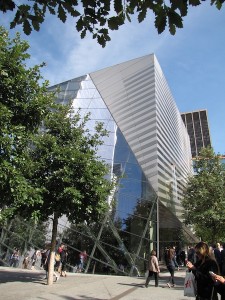
The elegant glass pavilion that gives entry to the 9/11 Memorial Museum, seen on a glorious September day.
It is, of course, a sobering experience to visit the 9/11 Museum. My sister and I visited on a gorgeous sunny September day, a day just like Sept. 11, 2001. Even the sun seems somber in such circumstances.
The first thing any visitor sees on entry are two 70-foot-tall steel pieces recovered from the towers and now rising in the pavilion’s atrium. Called tridents because each has three prongs, they were two of many such pieces that were part of the exterior design of the Twin Towers.
The tridents look like an elegant piece of modern art — if you don’t focus on their provenance. Or, they can be seen as hands reaching skyward in supplication.
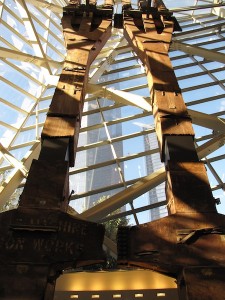
Tridents, two steel pieces salvaged from the Twin Towers, seen in the glass pavilion that gives access to the 9/11 Museum’s underground exhibits and artifacts.
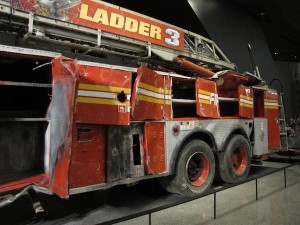
New York City fire truck, destroyed on 9/11 and now seen in the 9/11 Museum, just outside the entry point for the museum’s main historical exhibition. Photography is not allowed inside the exhibition.
It’s important to know that the museum’s core exhibition occupies much of the museum’s bottom level and is called the “September 11, 2001, Historical Exhibition.” We nearly missed it.
My only criticism of the museum is that neither the signage (well, any that I saw) nor the museum map made clear the significance of getting into that space at the bottom level.
We might have missed it but for museum staffers who more than once announced clearly to clusters of visitors that they must not skip the historical exhibition.
It is set up in three sections, devoted to events leading up to the attack, including the 1993 bombing at the trade center (which killed six); to the murderous events of the day itself, and to the aftermath.
Warning signs advise when an exhibit or experience may be disturbing. Tapes of cellphone calls from victims telling their families they loved them were one example. Those were indeed disturbing.
Events associated with the 9/11 attacks were thoroughly covered in the media; therefore, much will be familiar to visitors. However, the museum knits the material (and perhaps our fragmented memories) into a helpful whole.
Outside this main historical section, some displays are devoted to the destroyed buildings themselves, particularly the Twin Towers. One panel was packed with mind-boggling trivia.
The World Trade Center and the towers appear in my book “Travia: The Ultimate Book of Travel Trivia,” but I did not have these factoids:
• There were 43,600 windows in the Twin Towers, and it took two months to wash them all.
• On windy days, the towers swayed 12 inches from side to side.
• And, the South Tower Observation Deck’s outdoor viewing platform, at 1,377 feet, was the highest in the world. On a clear day, one could see 45 miles in every direction.
The original World Trade Center, although a workplace for 50,000, was a major tourist attraction. Now, I believe it will attract even more visitors.
The new 1,776-foot One World Trade Center (popularly called Freedom Tower) seems built to be photographed.
Half the World Trade Center’s 16 acres are devoted to the 9/11 Memorial, which encompasses, besides the museum, the reflecting pools that honor all 2,983 victims of the 1993 and 2011 attacks.
The plaza also features hundreds of oak trees, plus benches and pathways. It’s a place for living in the present, as well as remembering.
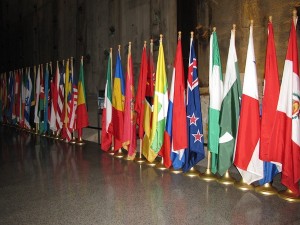
Displayed inside the 9/11 Museum, a lineup of flags from the more than 90 countries whose citizens were victims on 9/11.
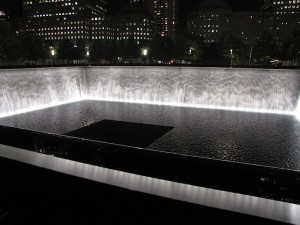
One of two memorial reflecting pools, this one on the footprint of the South Tower, seen at night at the World Trade Center.
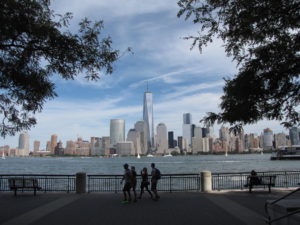
The New York City skyline, with One World Trade Center — a natural for photography — standing tallest, seen from the Jersey City, N.J., pier.
For more about New York City, we offer at BestTripChoices.com the following, under the headline: No Rotten Apple here
https://besttripchoices.com/us-cities/new-york-city-new-york/
This blog and its photos are by Nadine Godwin, BestTripChoices.com editorial director and contributor to the trade newspaper, Travel Weekly. She also is the author of “Travia: The Ultimate Book of Travel Trivia,” which was published by The Intrepid Traveler.
